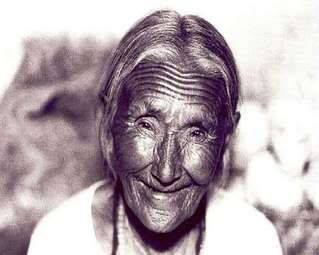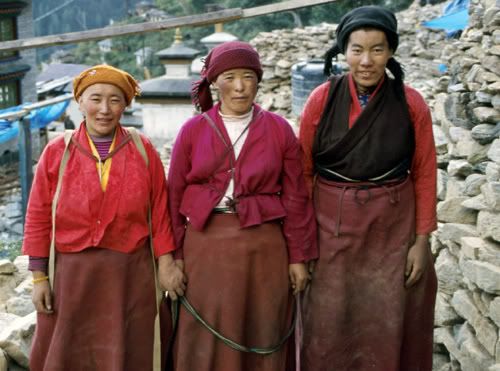- Drea Knufken with Lys Anzia – WNN – Women News Network

-Tibetan
Nun Living in Exile in India-
photo image ©Denny Long, Hypatia Trust Project
2001
“It is only in exile that I am free to speak my life’s joys and sorrows,” says Ama Adhe, from her book “Ama Adhe : The Voice that Remembers,” a 1997 Wisdom Books publication by Adhe Tapontsang - as told to Joy Blakeslee.
Ama Adhe’s book is “a moving testimony which serves to further international awareness and understanding,” said Amnesty International. It is “the story of a woman who sustained her human dignity, integrity, and compassion in the face of immense degradation and suffering … both compelling and inspiring,” said Feminist Bookstore News.
Gathering true and accurate reports in the stories of the suffering of refugee women is vital to improving conditions for all women worldwide. With clear memories of homeland each refugee suffers from terrible homesickness in addition to the recovery from the traumas of incarceration, violence, abuse, and all elements of conflict.
Tibetan refugee Ama Adhe Tapontsang’s story is no exception. Her triumph over insurmountable odds through conditions of personal abuse and torture during her 27 year stay in prison was soothed by memories of her love for people and the pristine beauty of the land where she was born. During those terrible days appreciation for the land and her family’s culture helped lift Ame Adhe to a different time…a different world.
The Tibetan Women’s Association knows deeply in order for a culture to survive, its lands need to be protected. In addition to being strong advocates for Tibetan women’s rights, TWA plays a powerful role in the protection of land by focusing on local environmental issues. To aide these campaigns the regional chapters of the Tibetan Women’s Association hold regular cleanup drives in their areas, as well as organizing local reforestation programs. Recently on 6 July, 2007 the TWA planted fruit tree seeds blessed by His Holiness the Dalai Lama, as they do each year, across the Tibetan refugee settlements in celebration of His Holiness’ birthday.
Before 1959, six million Tibetans inhabited the region of China known today as the TAR – the Tibetan Autonomous Region. Today government accountability in reporting conditions for women also spills over to needs for accountability in reporting environmental conditions too for specific regions in the TAR. As the Tibetan people co-existed for centuries within the Tibetan environment, official policies after 1959 in the region envisioned a new use with the land. It included endless opportunities for roads, mines, dams, mass agriculture, “modernization” and industry.
Today the need for greater accountability and accurate reporting is vital for human rights advocates working inside the People’s Republic of China, India, Nepal and regions surrounding the Tibetan Autonomous Region. In March 2007, the NGO World Wildlife Fund reported that four of the ten rivers of the world listed as the greatest environmental dangers in the world are located in the Tibetan regions of China. These rivers which currently face possible serious environmental impact are the Yangtze (Dri Chu in Tibetan), the Salween (Ngulchu in Tibetan), the Mekong (Za Chu in Tibetan) and the Indus (Sengye Khabab in Tibetan). These deteriorating conditions are due partially to problems occurring from hydro-power dams, unchecked pollution, overfishing and climate change.
Recently UNESCO’s WHC – World Heritage Committee has expressed “serious concern over the potential significant impact” to the environment and to people who are dependent on these rivers for life stating that the World Heritage Committee has not (to date) been given enough information by the Chinese government to make proper assessments of the situation.
The Tibetan Plateau, known as the “Roof of the World,” is a 16,000-foot-plus region that has contained more than 2,000 natural lakes, watersheds for India, Pakistan, China and Bangladesh - enough water for 47% of the world’s population. This is a land where thousand-year-old forests grow on steep hills, rivers scream down impossible slopes, and there’s enough sunlight to make this place second only to the Sahara desert for solar wattage potential.
Suffering of the land’s environment and great suffering of the people in specific regions under environmental stress often go hand in hand. As awareness of the history of the torture and mistreatment of women in the TAR – Tibetan Autonomous Region – becomes more available, it is hoped that additional environmental informational reports can also be made available to CEDAW. Environmental problems impact women just as strongly as other concerns for women. As women care-take the family they are no strangers to suffering from shortages of food or water.
In the name of maintaining a “healthy social environment” the women of the Tibetan Women’s Association also give lectures and public information to poor and needy families regarding environment, health, diet and hygiene. They offer a “broom squad” service during religious gatherings and other community events to ensure that spaces are left clean and safe. For the TWA the issue of care-taking the environment is all-encompassing—not just physical, but social, cultural, and political as well.
As a grassroots organization TWA is focusing its efforts to help those who have been affected by the drastic changes to the Tibetan region over the past 75 years.
“The right to life is the most important of all human rights legally guaranteed and protected by contemporary international law. On the other hand, the right to life is the one which is, most of all, connected to and dependent on proper protection of the human environment . . . we cannot forget that this is an original right from which all other human rights derive,” wrote Laura S. Ziemer in Harvard Human Rights Journal article Vol. 14 – 2001.
Seven years ago, in 2000, UN CEDAW - the Committee on the Elimination of Discrimination Against Women - linked environment to the right to health in its Concluding Observations on the State Report of Romania, expressing its “concern about the situation of the environment, including industrial accidents, and their impact on women’s health.” Today similar concerns may be rising in areas inside the Tibetan Autonomous Region.
During the United Nations 36th Session of CEDAW - The Committee on the Elimination of Discrimination Against Women, in August 2006, Human Rights in China - HRIC’s director - Sharon Horn, spoke on the importance of accuracy in reporting atrocities and human rights abuses before the United Nations CEDAW session. Mentioning the “Lack of transparency and access to information” HRIC’s director Horn said that lack of transparency in reporting “has negatively affected the domestic implementation of CEDAW.”
“Without grassroots ownership of the important issue of gender empowerment, the Chinese Government cannot build meaningful partnership with both local and international actors to form useful solutions for the advancement of women,” said HRIC’s director. “Fundamentally, the lack of access to transparent information undermines government accountability and prevents domestic civil society actors, ordinary citizens and the media from effectively contributing to the promoting of women’s rights in China,” she said. “Our Tibetan and Uyghur colleagues have documented the persecution of Tibetan nuns and adverse effects of China’s family planning policies on Tibetan and Uyghur women,” continued HRIC’s director Sharon Horn. “The China Report, however, does not examine the situation of minority women except in very general terms, and collapses ‘minority areas’ alongside poor and rural areas,” she added.
“I am free now. There are no guards outside my door. There is enough to eat. Yet an exile can never forget the severed roots of beginnings, the precious fragments of which are always within the heart. . . As I pass through the hours of each day, I feel my memories remains with the memories of my family and friends whose bones have become part of a land now tread by strangers,” said Adhe in “The Voice that Remembers.”
“There was no choice but for me to make this journey,” Adhe continues in her book. “Somehow I have survived, a witness to the voices of my dying compatriots, my family and friends. Those I once knew are gone, and I have given them my solemn promise that somehow their lives will not be wiped out, forgotten, and confused within a web of history that has been rewritten by those who find it useful to destroy the memory of many I have known and loved. Fulfilling this promise is the only purpose remaining in my life.”
Ama Adhe lives today in Dharamsala, India.
Today the Central Executive Committee of the Tibetan Women’s Association is advocating strongly for greater transparency in the process of reporting to UN CEDAW. “In view of the grave situations faced by Tibetan women in Tibet, we urge the Chinese authorities to invite the Council’s Special Rapporteur on Violence Against Women on an official fact-finding mission which will include an extensive program in Tibetan areas of present-day China.”
Based in Dharamsala, India, the Tibetan Women’s Association has 47 branches in countries including Nepal, the U.S., Japan and various countries in Europe, with 13,000+ members. Their objectives include raising global awareness of the situation in Tibet, empowering women in exile, addressing human rights abuses perpetrated against Tibetan women, preserving Tibetan culture and environment, and to “join hands with the women of the world to promote peace and justice for all.”
Founded by Chinese students and scholars in March 1989, Human Rights in China (HRIC) is an international, Chinese, non-governmental organization with a mission to promote international human rights and advance the institutional protection of these rights in the People’s Republic of China (China). HRIC’s board and staff include Chinese, North American, and European individuals devoted to fostering greater space for democratic reforms and social justice.

-Tibetan
Refugee Women in Thubten Choling near Junbesi, Nepal-
photo image ©Arie van
der Velden 2002
________________________________________________
Sources for this article include Wisdom Publications, Harvard Human
Rights Journal, Feminist Bookstore News, Tibetan Women’s Association, UN CEDAW,
Amnesty International, HRIC – Human Rights in China, Tibet Autonomous Region’s
White Papers, Tibet Environmental Watch, the U.S. National Academy of Science,
“The Voice that Remembers” by Adhe Tapontsang, The American University, UNESCAP
– The United Nations Economic and Social Commission for Asia and the Pacific and
The WWF – World Wildlife Federation.
____________________________________
This article was co-authored by humanitarian journalist Drea Knufken and WNN
director and international women’s advocate, Lys
Anzia.
____________________________________
©2007 WNN - Women News Network